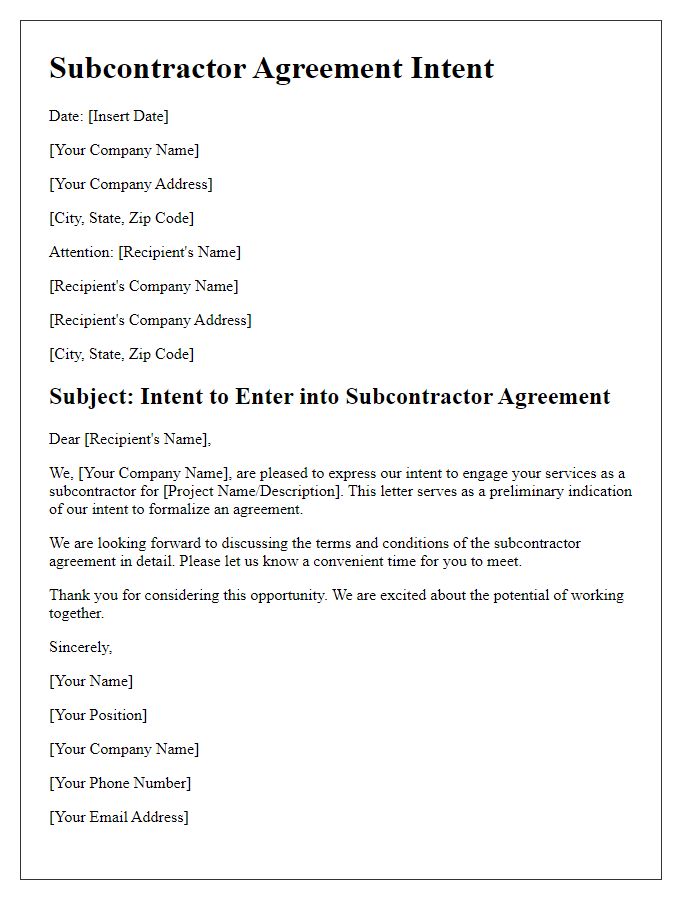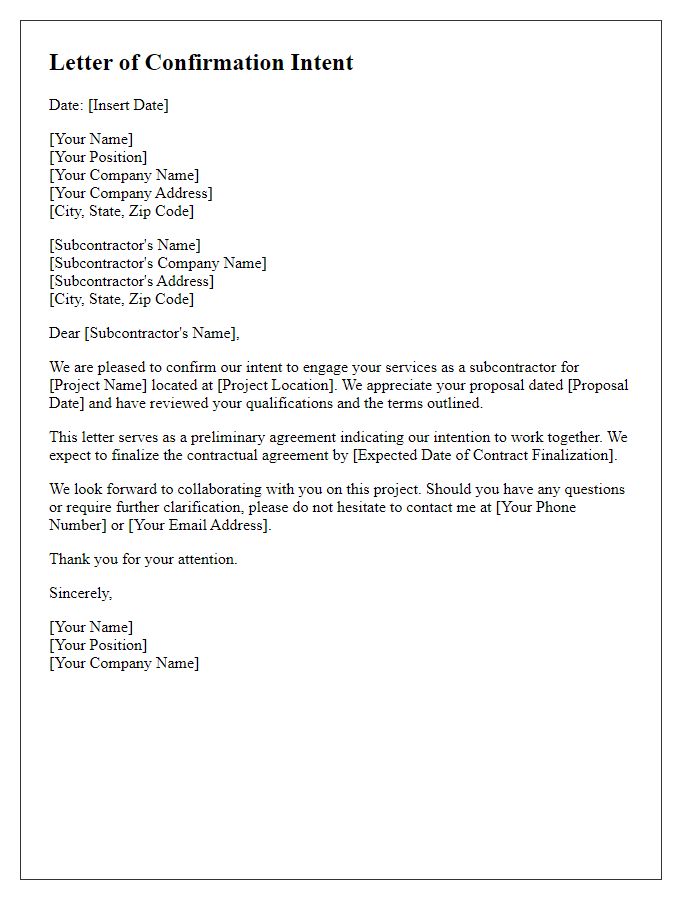Are you looking to kickstart a new project with a subcontractor but don't know where to begin? A letter of intent is a great way to outline your intentions and establish a professional relationship. In this article, we'll walk you through a simple yet effective letter template that will help you convey your project goals clearly and concisely. So, let's dive in and discover how to craft the perfect letter of intent!

Clear Identification of Parties
The subcontractor letter of intent marks an essential step in formalizing an agreement between parties involved in a construction project, such as the primary contractor and the subcontractor. It should explicitly state the names of the main contractor company, including their registered business name, and the subcontractor's company name with relevant legal identification numbers, such as the Employer Identification Number (EIN) in the United States. Clear delineation of addresses for both entities, alongside telephone numbers and email communications, enhances transparency and establishes communication channels. Including the project title and location addresses, such as street, city, and state, creates a context for the intended work, allowing both parties to share a mutual understanding of the project scope while showcasing the collaborative nature of the forthcoming agreement.
Scope of Work and Responsibilities
The subcontractor letter of intent outlines the preliminary agreement between parties regarding the specific scope of work and responsibilities associated with a construction project. This document typically includes essential details such as the project name, location (for example, Main Street Bridge, Springfield), and project timeline (start date: January 5, 2024, completion date: March 15, 2024). It specifies the tasks to be performed, such as electrical installations, plumbing, or masonry work, along with any relevant compliance requirements, including adherence to local building codes and safety regulations. The letter also delineates responsibilities, like procurement of materials, labor management, and regular progress reporting to the general contractor. A clear outline of payment terms, including milestones and invoicing procedures, ensures financial transparency throughout the project.
Terms and Conditions
A subcontractor letter of intent outlines initial agreements and intentions between parties before formal contracting. Key elements include project details, timelines, and specific terms. For instance, the scope of work, including demolition, framing, or electrical installations, must be clearly stated. Payment terms should detail amounts, schedules, and preferred payment methods. Identification of key stakeholders, including general contractor names and project managers, adds clarity. Additionally, specifying insurance requirements and compliance with local regulations, such as those from OSHA for safety standards, ensures legal protection. Lastly, including a non-disclosure clause may protect sensitive information shared during negotiation phases.
Payment Details and Schedule
A subcontractor letter of intent (LOI) outlines key payment details and an expected schedule for project milestones. Upon entering a contract agreement, the subcontractor expects payments to align with specific project phases, such as material procurement, labor completion, and project deliverables. For instance, a considerable initial payment (often 25% of the total project cost) may be due upon signing the contract, followed by milestone payments contingent on project completion stages (typically at 30%, 60%, and 90% completion). Payment methods--such as electronic transfer or check--should also be clearly specified. Additionally, penalties for late payments, such as an interest rate of 1.5% per month, can be included to encourage timely payments. The completion date is crucial, with anticipated project wrap-up set for March 15, 2024, as per the contractor's timeline.
Confidentiality and Non-Disclosure Clause
The confidentiality and non-disclosure clause protects sensitive information during negotiations between the primary contractor and the subcontractor. This clause establishes that all shared proprietary information, including business strategies, financial data, project specifics, and personnel details, shall remain confidential and not be disclosed to external parties. The timeframe for confidentiality typically extends for three to five years after project completion, ensuring long-term protection. Violations can result in legal repercussions, including damages or injunctions. The clause applies universally, to both verbal and written communication, safeguarding the integrity of the primary contractor's operations and the trust established in the contractor-subcontractor relationship.













Comments